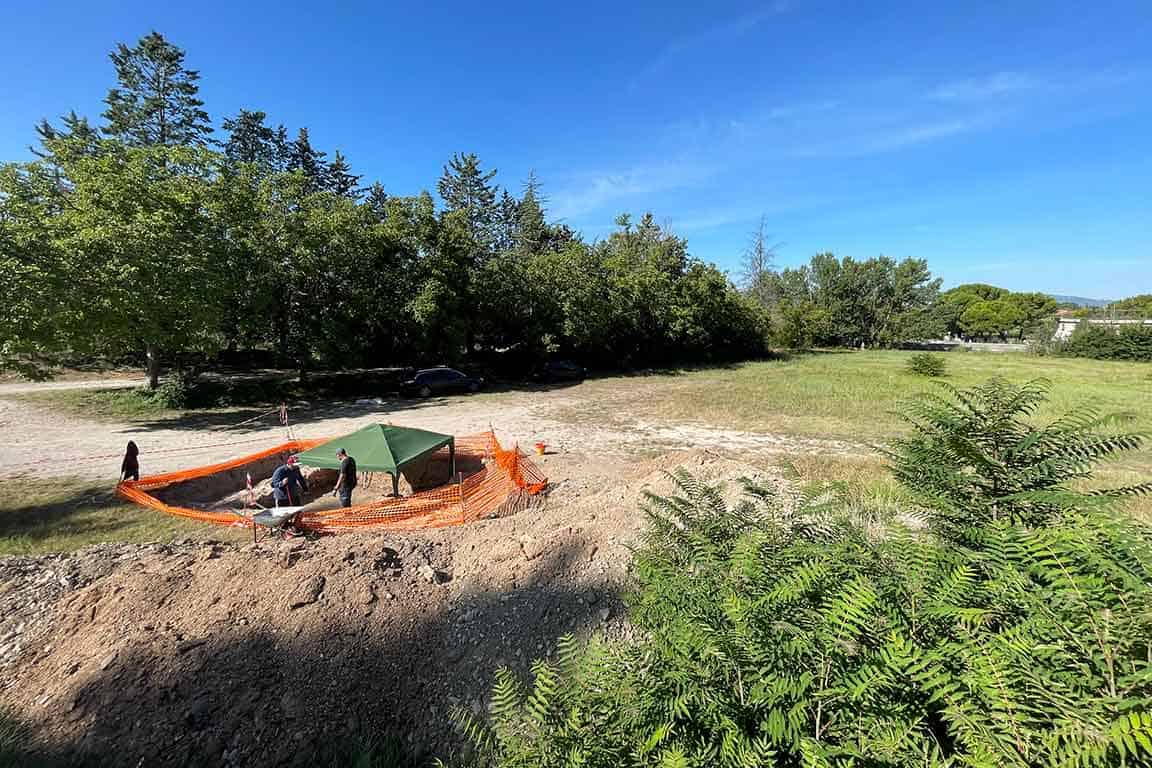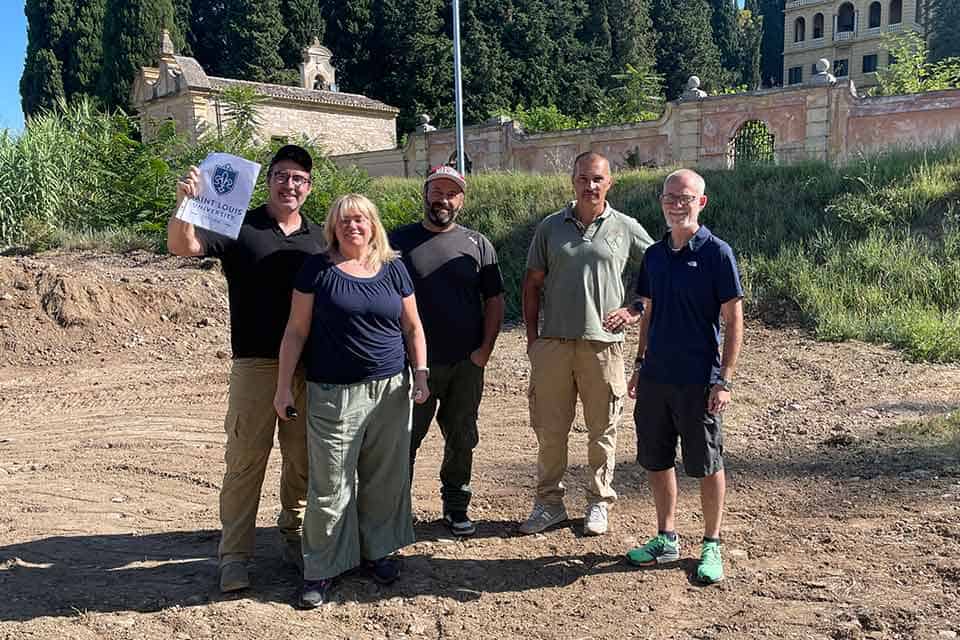Lost and Found
Spello is a picturesque village in Italy where the meandering cobblestone streets are lined with baskets of flowers. Enclosed in a circuit of medieval stone walls and nestled in the verdant rolling hills of the central region of Umbria, Spello is considered one of the country’s most beautiful villages.
The scenery, however, is not what attracted Dr. Douglas Boin to Spello. An expert in the religious transformation of the Roman Empire in the fourth century, the Saint Louis University history professor was drawn to the village by a piece of stone sitting in a room under a frescoed ceiling and dramatic lighting. The stone contains a rescript, a message from Emperor Constantine giving villagers permission to build a temple in Spello to celebrate a religious festival in their own town rather than making the long journey to another. The only condition was that the temple be dedicated to worshipping Constantine’s imperial ancestors. This rescript was produced at a time when the Roman Empire was straddling the lines between pagan and Christian religions.
Over his many years of research into fourth-century antiquities, Boin came across articles and footnotes that mentioned the rescript, which was discovered in the 1700s near Villa Fidelia, a resplendent Renaissance home built outside Spello’s walls.
“It’s a trophy piece and by far the most famous piece of antiquity to come from Spello,” he said. “It sparked my interest because anytime you can see something written, whether on paper or stone, it can bridge a gap in time and help us make sense of history. So, my colleagues and I decided to take a road trip to see it.”
The Latin inscription on the rescript references a temple of opere magnifico, roughly translated as “splendid endeavor.” After seeing the rescript, Boin and colleagues stopped for a glass of wine and began to muse. Where was this splendid temple erected? What did it look like? How did it impress itself on the village at that time?
Parking Lot Full
Boin returned home, and in 2020, he received seed money from SLU to search the archives in the region’s capital, Perugia, a university city perched on a hill in Umbria down the road from Assisi. While nothing above ground gave Boin clues regarding the temple’s location, he found enough information in letters and diaries to justify a deeper dive.
In 2021, Boin received another grant from SLU to put together a team from the British School at Rome to conduct a geophysical survey on the grounds of Villa Fidelia. The Italian government gave Boin and his team one day to use magnetometry and ground-penetrating radar to find anything worth excavating.
By the end of the day, the team found nothing — no actionable data that would support further exploration or excavation. The team leader called Boin to deliver the disappointing news, but he also mentioned that as they were wrapping up, the government said the team could search the earthen parking lot outside the villa if Boin wished.
“An unobstructed field to surveyors is like an open road to a Formula 1 driver,” Boin said. “They were itching to use their equipment to take a look, so I said, ‘Do it.’”
It was good that they did. When the geophysical survey was processed several weeks later, it showed what appeared to be three distinct walls approximately four feet below the surface of the parking lot.
“The images showed substantial remains of a gigantic structure with a defined shape,” he said. “We didn’t know what it was, but whatever it was could tell us a lot about the suburbs of the village and how it developed over time.”
The Big Dig
Boin assembled a team of professional archaeologists to begin excavating the parking lot. The team included the director of field operations, Dr. Letizia Ceccarelli of Milan; excavation experts Francesco Giorgi and Danilo Nati; and team photographer/drone operation leader, Luca Primavesi of Milan. The team had two weeks to determine whether what they saw on the radar was real.
The first dig was in mid-July 2023. It started at 6 a.m., and the day was already hot. A backhoe operator who, according to Boin, manipulated the claw with the grace and precision of a ballet dancer, gently scraped the compact earth. By 10 a.m., the operator carved out a 16-by-16-foot trench that seemed void of discovery.
“It was the most terrifying professional experience of my life,” Boin said. “I kept a poker face and stuffed down my anxiety about wasting everyone’s time, energy and resources.”
Then Giorgi, one of Boin’s colleagues, noticed a layer of pink sediment that usually signals to archeologists in parts of Italy that they are getting close to something ancient. Soon after, the claw caught on to something so substantial it could not continue pulling back. Boin and his colleagues jumped into the trench with precision tools and revealed three adjoining walls, each nearly four feet wide.
“The walls of a Roman house are about half that width, so we knew we found something more monumental than a house,” Boin said. “We thought this might be an ancient imperial cult temple. We were ecstatic.”
Over the next two weeks, Boin and his colleagues unearthed several layers of sediment, exposing artifacts, animal bones, coins, ceramics and bronze artifacts, all of which are useful in dating ruins.
“I can’t describe how rewarding it is as a historian to come in contact with artifacts that historical actors have left behind,” Boin said. “It’s like finding new, never-before-seen presidential letters.”
Boin said the artifacts led his team to believe the temple was used by at least three groups for three different purposes over three different periods of time.
“When we stood in the trench, our feet were in fourth century B.C., and at the top of the trench, we were in fourth century C.E.,” Boin said. “We time traveled through 800 years of history.”
Paganism and Pluralism
Boin said the temple is significant because it can offer insights into the social change from pagan gods to Christianity within the Roman Empire.
Although Emperor Constantine was the first emperor to profess Christianity, it appears he entertained different religious values simultaneously and supported “imperial cult” traditions, which were based on the Roman belief that emperors were divine figures. It would take almost 70 years for Christianity to become the official religion of the Roman Empire under Emperor Theodosius.
“The idea that Constantine was just as involved in promoting a pagan cult of the emperors as he is in embracing his newfound Christianity is one of those weird chapters in history that fascinates me,” Boin said. “It shows us history is not as linear as you might think. The past zigzags and gets a little messy. This temple gives us a conversation piece — a place to stop and wonder how confusing and uncertain the trajectory of these people might have been.”
Boin said there is evidence from other locations throughout the Roman world that Christian rulers supported imperial cult practices, but those findings have been small and inconsequential compared to the Spello discovery.
Scaling Up
In January 2024, Boin and his team announced their findings in Chicago at the annual meeting of the Archaeological Institute of America. He said jaws dropped when he told peers how much they accomplished with well-managed funding and a small team.
“The Spello Project shows what you can do with a hunch and an entrepreneurial spirit,” he said. “We found people who trusted us to see if we could make a contribution to history. It’s a testament to the research support that SLU provides and an amazing vote of confidence in me and my colleagues.”
Media coverage following the discovery has been overwhelming for Boin, who finds himself “wordless” when trying to capture the scope of the endeavor. He likens it to designing a rover and launching it into space. News outlets throughout the world, including The Jerusalem Post, the Times of India and the Miami Herald, picked up on the story. His team’s work has been featured in Smithsonian Magazine, Newsweek, Archaeology News and on CBS News.
Boin said the next step is to scale up the Spello Project. Boin said much remains unknown about the temple and whether it is the one Constantine sanctioned in the rescript. When Boin returns to the villa to explore further, he will bring SLU students into the field with him.
“That is an absolute priority,” he said. “I started my career 20 years ago as a graduate student in Italy excavating one of the oldest synagogues in Europe. That lit a fire under me and set me on my path to becoming a history professor. I would love to use this project to pay it forward and give a student a similar opportunity and hopefully create the next generation of historians.”
Details about the temple’s discovery are being prepared for publication in the American Journal of Archaeology.



















